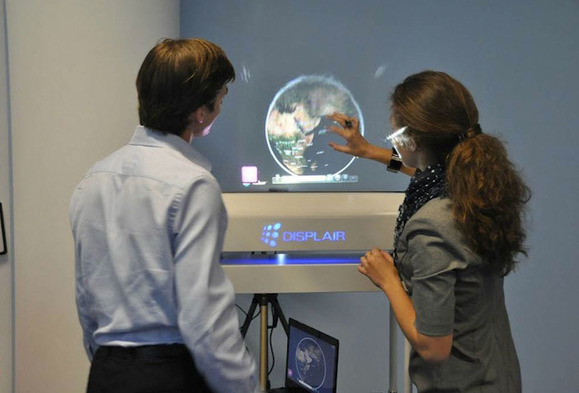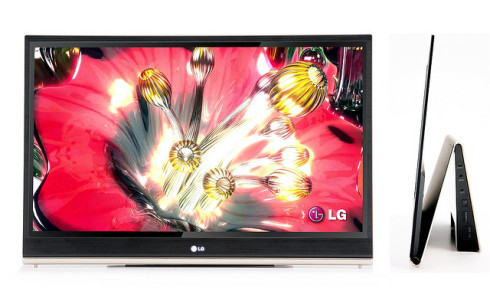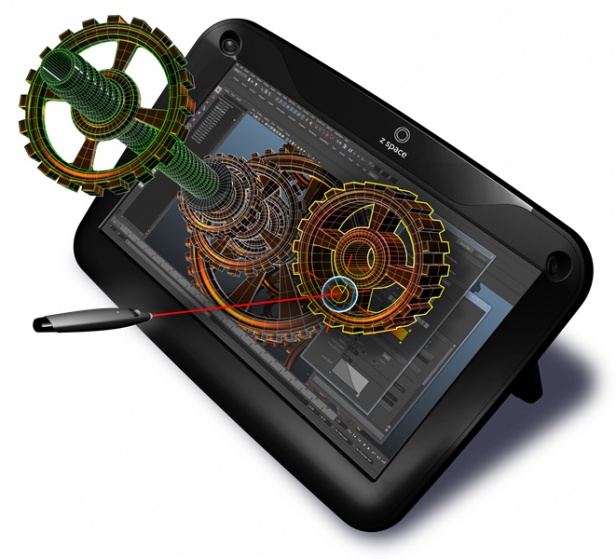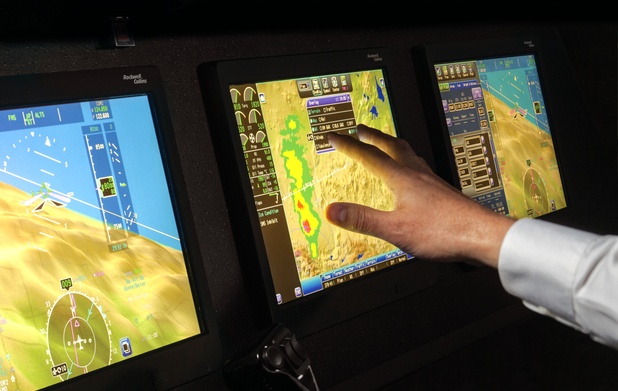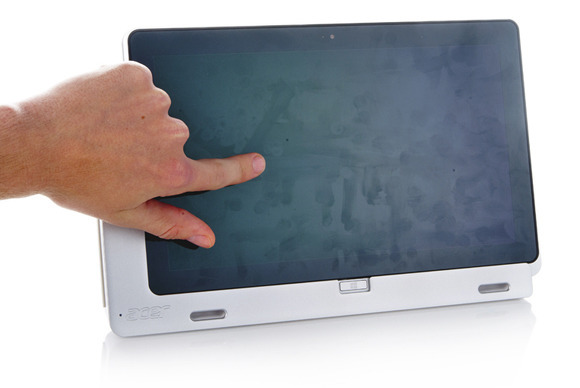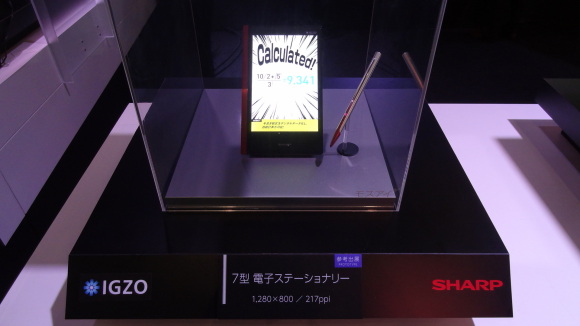Display Technology News Roundup 5.6.2014

Image via Cypress Semiconductor / Electronics Weekly
What are the design considerations for large-area touchscreens? "As screen sizes increase, the main challenge for capacitive touch is maintaining the same performance users have come to expect from a mobile phone but over a larger screen. This means scanning more intersections, over more surface area, in the same amount of time. ...It is challenging for large screens to maintain fast refresh rates because the touch controller needs to sweep greater surface area, gather data from all intersections, and process that data." via Electronics Weekly
Why Are Mobile Display Revenues Overtaking TV Displays? "With larger display area and comparatively higher unit prices, LCD TV panels have generated a majority of FPD revenues since 2006, but over the past three years, the market for mobile devices has expanded. The recent trend toward higher resolutions, slimmer and more lightweight specifications, wider viewing angle, lower power consumption, and the emergence of LTPS and OLED displays are causing mobile display revenues to soar." via PCB007
Why Did Apple Just Buy A Tiny Display Company And What Could It Mean? "Apple used to push display technology with its products, most notably when it brought the Retina Display to the iPhone. But that hasn’t been the case lately, which makes its recent acquisition of tiny LuxVue Technology all the more interesting. But LuxVue’s technology has fascinating implications around low power and high brightness and could eventually mean Apple will manufacture its own displays for the first time. It could also allow the company to gain technological leadership again, as it has with its own in-house chipmaking, which was also made possible by an acquisition that didn’t seem especially all that important at the time. In a scoop over at TechCrunch, Apple responded with its typical non-comment about what it intends to do with LuxVue and to say the company is little known would be a case in understatement." via Forbes
How Can Quantum Dots (QDs) Increase Display Color and Brightness with Less Power? "The optical and electrical properties of the manufactured crystals can vary markedly according to their size and shape: The bigger the dot, the larger its bandgap and the longer the wavelength it emits. The smaller the dot, the smaller its bandgap – which means a shorter wavelength due to the quantum confinement of electrons and holes in these nanomaterials. Quantum dots offer marked advantages over fixed-spectrum conventional phosphor technologies because QDs are tunable, so they can be induced to emit at a very narrow wavelength. Improvements to the technology in recent years are also making them more attractive." via Photonics
Why is smartphone component production causing LCD display shortages and hurting the display industry? "In recent months, there has been growing demand for a number of high-value components for smartphones and tablets, including fingerprint sensors, CPUs, cameras and touch controllers, along with 4K television timing controllers. According to NPD DisplaySearch large-area displays analyst Peter Su, semiconductor manufacturers in Taiwan have increasingly been prioritising the manufacturing of these higher-value components over timing controllers [T-cons] for LCD displays. In a statement, Su warns the prioritising of higher margin components is leading to a shortage of T-cons." via Smart Company
Display database for engineers Search thousands of display panels by multiple characteristics and compare results side-by-side using the display database multisearch.
Sharp improves TN LCD panels with clever light scattering optical film "Adding a film to a TN panel isn’t a new concept, but Sharp’s film promises to do a much better job of improving angled viewing. Typically, existing films only improve viewing horizontally, not vertically. Sharp’s new optical film improves both by scattering light and being able to control which direction that light is scattered in." via Geek
How have avionic displays entered the future? "Analog gauges, often referred to as “steam gauges,” ruled the instrument panels of all aircraft for nearly 80 years. But with the advent of powerful and inexpensive semiconductors, and the clarity of liquid crystal diode displays, it became easier to combine many instruments onto space-efficient, yet easy to read, glass screens called multi-function displays (MFDs). Along with advancements of glass display screen came synthetic vision systems (SVS). Loosely defined as real-time, 3D color imagery, SVS makes paper navigation products nearly obsolete. Instead, it uses a preloaded, internal database to create a pilot’s-eye view of the terrain the aircraft is passing over at that time." via Aviation Today
What are the challenges of designing automotive heads-up displays? "HUDs work by projecting an image, usually from a liquid crystal display (LCD), onto the windshield or a piece of glass above the instrument cluster. ...Designing a good HUD presents many challenges. It needs to have a very wide contrast ratio. It must display an image bright enough to be clearly seen on a sunny day, but also dim the image so that it does not obscure the driver’s vision at night." via EDN
How did Apple and Samsung get into a smartphone war? "The first products known to have been the focus of one of Samsung’s major price-fixing conspiracies were cathode-ray tubes (C.R.T.’s), which were once the technological standard for televisions and computer monitors. According to investigators in the U.S. and Europe, the scheme was quite structured: competitors secretly got together in what they called “Glass Meetings” at hotels and resorts around the world—in South Korea, Taiwan, Singapore, Japan, and at least eight other countries. Some of the meetings involved the most senior executives, while others were for lower-level operational managers. The executives sometimes held what they called “Green Meetings,” characterized by rounds of golf, during which the co-conspirators agreed to raise prices and cut production to receive higher profits than would have been possible had they actually competed with one another. The scheme was eventually exposed, and over the course of 2011 and 2012, Samsung was fined $32 million in the U.S., $21.5 million in South Korea, and $197 million by the European Commission." via Vanity Fair
How to Install a Heads-Up Display in a Fifth Gen Camaro "There’s just something about checking your speed, gas gauge, and tachometer without having to look down that makes driving a new Camaro quite enjoyable and, once you’ve experienced that luxury, it’s quite difficult to go back. Unfortunately, not every fifth-gen Camaro shipped from the factory with a HUD and if you’re in the market for a used 2010, or you’re an original owner who didn’t have the option available at the time of purchase, you might think you are out of luck. But fear not fans of the futuristic windshield gauge concept, Heads Up can be yours and it can even be installed in your own driveway with a couple of factory parts and a weekend worth of work, if you’re willing to put in the effort. That said, we should mention up front that this can be quite a daunting task if you’re easily intimidated by making a mess in your new Camaro and it certainly isn’t a modification for the faint of heart. You’re going to have to dig in deep and, at some point, wonder if you’ve made a major mistake." via GM High-Tech Performance
Do you have content to share with Display Alliance? Anyone can post press releases, white papers, commentary, videos, and more in the open section.
Will virtual reality (VR) make flat panel displays obsolete? ""A traditional display, especially larger ones, they're very expensive to manufacture and ship... it's literally just a lot of plastic and a lot of glass in a big box that has to be shipped across the world," Oculus VR founder Palmer Luckey continued. "Sometimes it breaks, then it has to sit on a giant store shelf until someone buys it. Once VR is commoditized, let's say 10 years from now, the tech from two years prior, you'll be able to buy a really good VR headset for $99, because there's not much material, once it's all commoditized..."" via Ars Technica
UK Developers Create Reach-Through Displays For Tabletops "Researchers from the University of Bristol have reportedly developed a new reach-through tabletop display with personal screens comprised of a curtain of mist, according to research scheduled to be presented later this month at an international conference on human-computer interaction. ...The device is known as MisTable and it is described as a tabletop system that combines a traditional interactive table with personal monitors built using fog between the user and the table’s surface." via redOrbit
New display brings the Internet to your wall "That's where Electric Objects, Jack Levine's new venture, comes in. He wants to take some of the more serene parts of the Internet out of that stress-inducing device sitting on your desk, and put them on your wall through a different kind of device. ...The product is still in the prototype phase. But the current unpriced model hacked together by Levine is bigger than an iPad and, at 23 inches, smaller than most TVs. A final, more polished version will include a screen designed to be on at all times, with sensors that detect if anyone is nearby, activating the screen. It will also have a tilt sensor to reorient itself in either landscape or portrait modes, and an ambient light sensor to keep the brightness low and subtle." via Fast Company
Why Some Doctors Like Google Glass So Much "At a recent event hosted by Google’s Cambridge branch, doctors from across the country came to show off how they’d thought of harnessing Glass for medicine. One presenter, Rafael Grossman, a surgeon based in Bangor, Maine, was the first person to use Glass during live surgery. He thinks the technique could help doctors teach new surgeons. But for the pilot at Beth Israel, video is off the table, at least for now. “We wanted to stay away from anything that could potentially be misconstrued as leaking patient information, so until we had a case study and a good foundation, we purposely stayed away from enabling the video feed,” says Horng." via MIT Technology Review
How tiny company Amorphyx is seeking to reshape the huge, mature business of manufacturing displays "Cowell and Amorphyx co-founder and chief executive John Brewer Jr. are preparing for a whirlwind, four-day trip to Taipei, Japan and South Korea, where they will meet with executives of major display manufacturing companies including Samsung and Sony. They hope to make progress toward an agreement to cooperate in testing and refining a process that would replace silicon-based transistors with amorphous metals-based resistors. Amorphyx has been doing this on a small scale in the lab, where it sprays two layers of metal compounds and an insulator onto wafers, then tests them for conductivity. Now it hopes to kick the process to a higher production volume. For the layperson, what this means is that displays built with Amorphyx's non-silicon process would consist of fewer layers than prevailing liquid-crystal manufacturing technologies, cost less and could be used on flexible surfaces." via Oregon Live
Are you an engineer or have display expertise? Email jason@displayalliance.com to be featured in the interviews section.
Shape-Shifting Touchscreen Buttons Head to Market "That technology was developed by startup Tactus Technology, which uses tiny fluid-filled channels and elastic blisters to make buttons rise up from a device’s screen and then disappear without trace when they’re no longer needed (see "Demo: A Shape-Shifting Smartphone Touch Screen"). Electronics manufacturing giant Wistron has now modified equipment at one of its factories in China to produce touch-screen panels with the shape-shifting technology inside. Wistron is one of the world’s largest electronics manufacturers; it’s made devices for brands including BlackBerry, Apple, and Acer. The company also recently became an investor in Tactus." via MIT Technology Review
A Joystick-Inspired Interface Could Solve Smartwatch Displays' Biggest Problem "Think of the way we used to use those small nubs located in the middle of an older laptop’s keyboard to move the cursor, and you’ll understand how this concept — created by Robert Xiao, Gierad Laput and Chris Harrison — works. Except that instead of a cursor, it’s navigating a mobile device’s UI that usually relies on taps and gestures. The problem is that your fingers are usually far too large to use all the same gestures you rely on with your smartphone on a watch’s tiny touchscreen. And you usually end up blocking the display in the process, making it even more difficult. So this concept reproduces most of that functionality with a watch display that can be subtly tilted side to side, up and down, rotated, and even pressed like a button." via Gizmodo
Should touchscreens be more intuitive? "Chris Harrison from CMU's Future Interfaces Group thinks modern, "flat" software doesn't profit from our dexterity with real-world tools like cameras, markers or erasers. To prove it, he created TouchTools, which lets you manipulate tools on the screen just as you would in real life. By touching the display with a grabbing motion, for example, a realistic-looking tape measure appears, and if you grab the "tape," you can unsheathe it like the real McCoy. " via engadget
Japan’s New Floating Touchscreen "The process is very fast paced, actually...allowing for highly responsive image manipulation. Hundreds of pictures are taken per second by stereo cameras. This allows the technology to precisely track a user’s hand and finger gestures as they relate to the floating images on the screen. These gestures are then translated into commands by computer software. Professor Ishikawa explains the advantage of gesture technology: “In hospitals and such during surgery, when one’s hands are dirty, it’s still possible to use this, or to use it in a variety of situations at a construction site.”" via Trefis
Atmel Announces Next-Gen Touchscreen Controllers "Atmel is well-known in the context of MCUs and FPGAs -- but it is also a major player with regard to touchscreen technology, especially in the large format screen space. ...The mXT1066T2 and mXT1068T2 controllers support both mutual-capacitance and self-capacitance sensing. By intelligently switching back and forth between the two and using a hybrid approach, designers can achieve optimal power consumption and noise immunity, even in high humidity and moisture environments, while supporting bare finger and gloved operation. Additionally, mXT1068T2 controllers supports hover operation in which the user's finger can be up to 20mm above the touch surface." via EE Times
Touchscreen Interface Based on Little Mobile Robots "Thumbles features tiny little omnidirectional robots that live on top of a projected screen. By grabbing them and dragging them around as they try to drive around, you can experience a completely new type of physical interactivity. What makes Thumbles unique is that the robots can move by themselves. They can provide force feedback, or dynamically form different kinds of physical controls, or act as virtual representations of things like molecules or mechanical structures. (Video)" via IEEE Spectrum
Could 'Star Wars' holographic displays become a reality? "HP Labs spinout Leia believes it is. Using a clever system of diffraction gratings, its small displays produce 64 different versions of each image, allowing a viewer to move around an object or person shown on the display as if it was right in the room with them. CEO David Fattal spoke to an eager crowd of imaging researchers at Stanford University about his company’s progress since it separated from HP. While the concepts behind Leia are the same as when the team’s work at HP was first published in Nature last year, the new company now has full color prototypes with improved resolution as it prepares for a product launch. Key to Leia’s technology is the use of fairly simple diffraction gratings at each pixel to redirect the backlight in different directions. " via ExtremeTech
What did you think about today's news? Leave a comment here and share your thoughts.
 Display Alliance
Display Alliance

